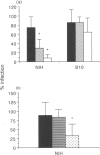Abstract
Groups of NIH and C57BL/10 (B10) mice were vaccinated subcutaneously with excretory/secretory material from the nematode parasite Trichinella spiralis using a variety of different adjuvants, i.e. complete Freund's adjuvant (CFA), 'TiterMax', alum and ISCOMs. ISCOMs were also given orally. NIH mice, known to be rapid responders to T. spiralis, expelled their worms earlier than usual with vaccination. The slow-responder B10 mice did not expel worms any earlier, no matter which adjuvant was used. The antibody isotype response profiles following vaccination with the four adjuvants did not differ significantly; however NIH mice generally produced higher levels of antibody than B10 and CFA induced the highest overall response. NIH cells yielded stimulation indices far in excess of the B10 following in vitro stimulation with T. spiralis antigen. Secretion of interleukin-5 (IL-5) and interferon-gamma (IFN-gamma) by these cells followed similar trends, i.e. higher levels from NIH than B10. A high IL-5 level in the NIH strain was accompanied by low-level IFN-gamma production following infection, whereas the IFN-gamma response was not observed in B10 supernatants. This study shows that vaccination using these adjuvants did not appear to modify the immune response qualitatively, but the magnitude of the response was affected greatly.
Full text
PDF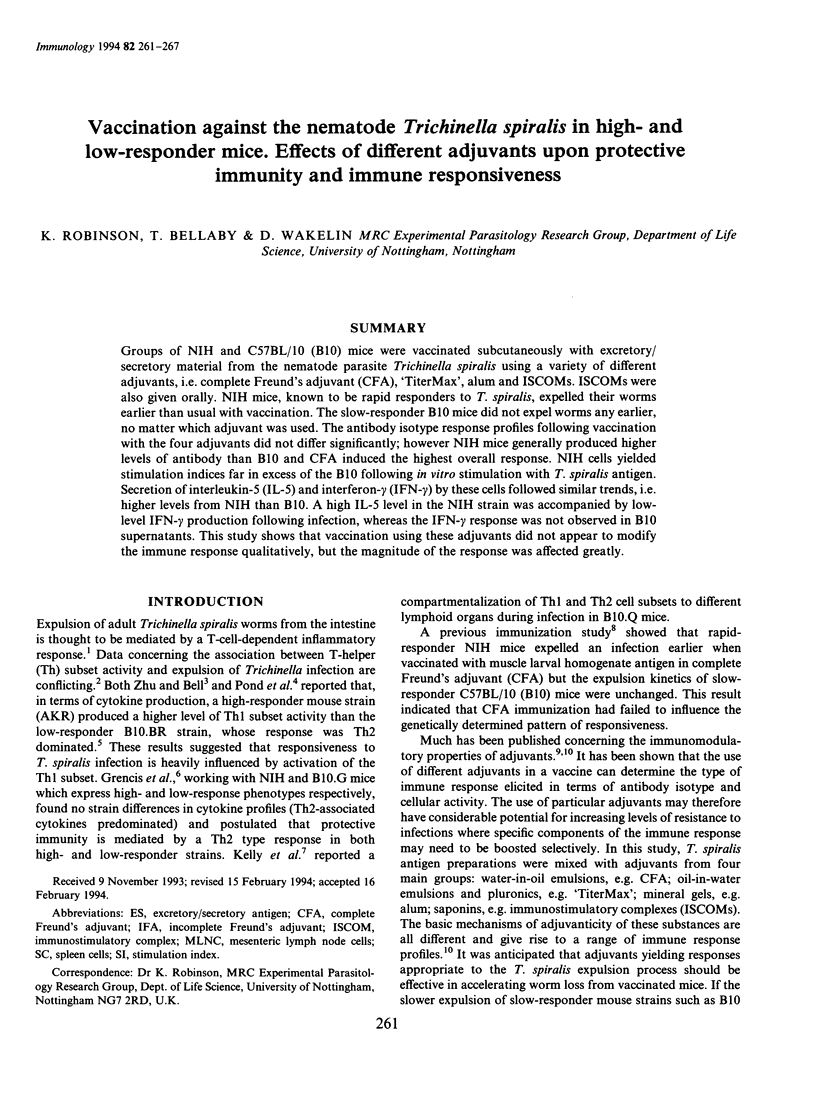
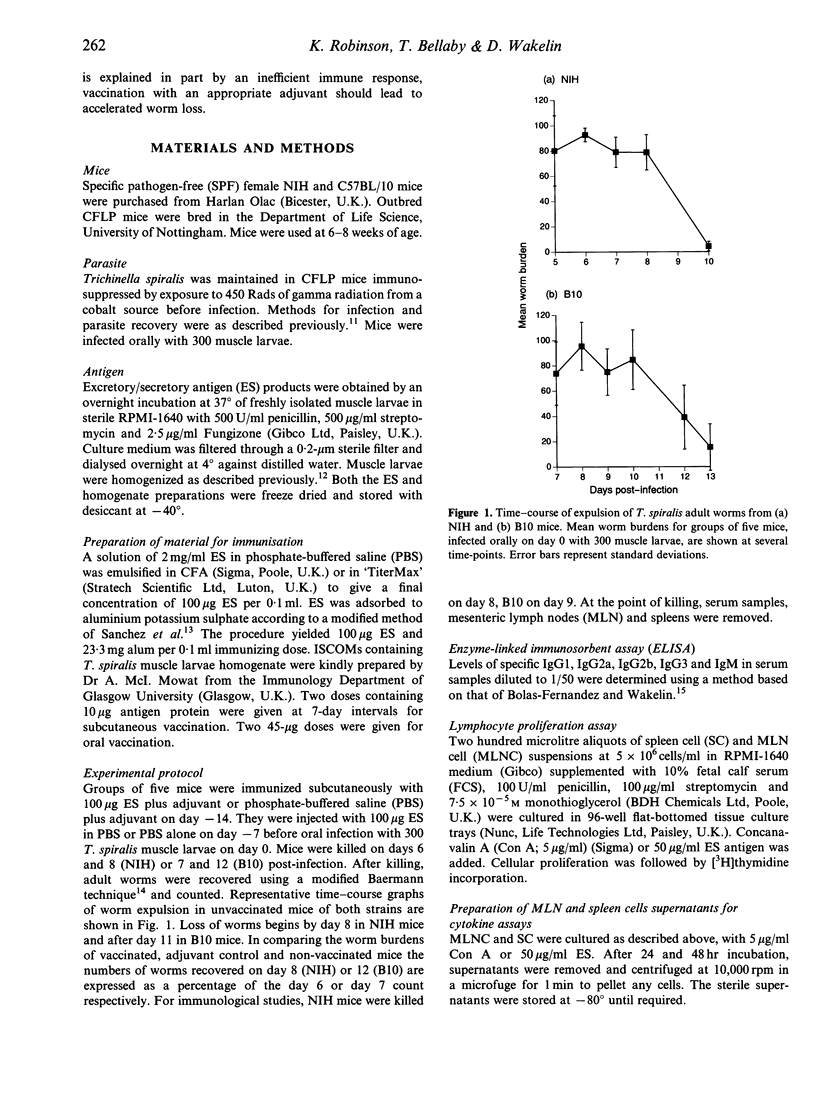
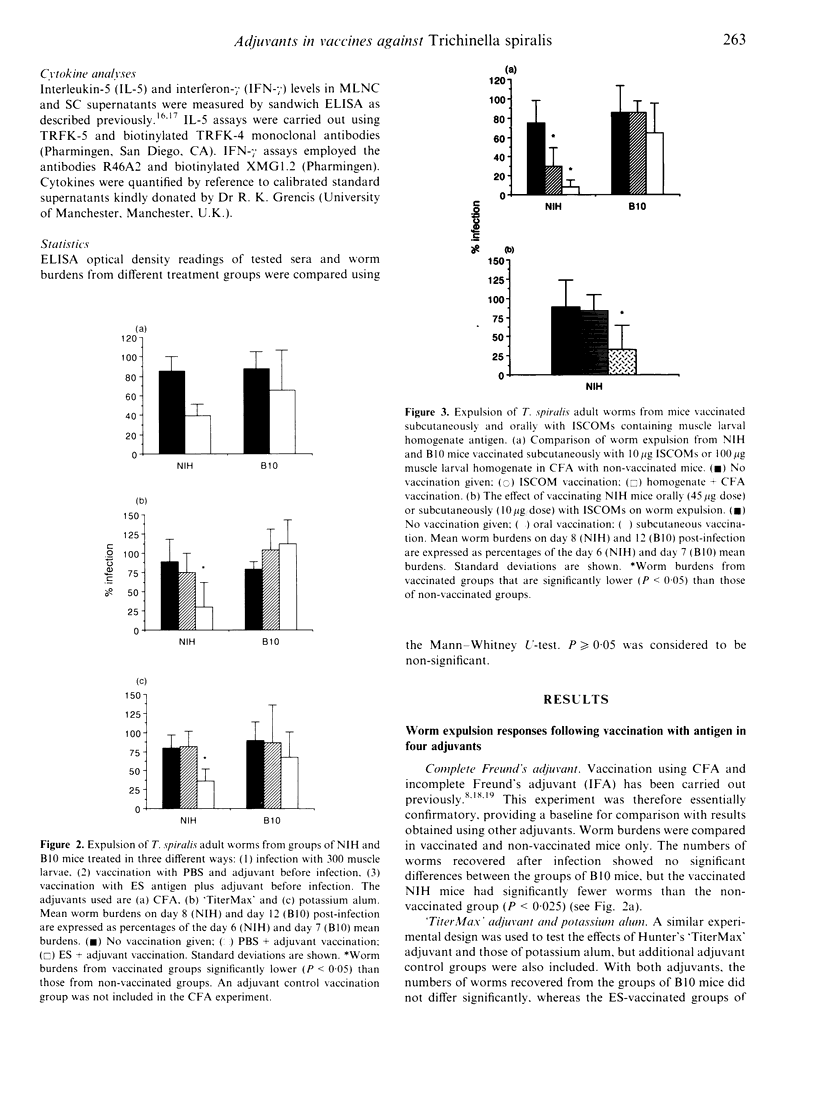
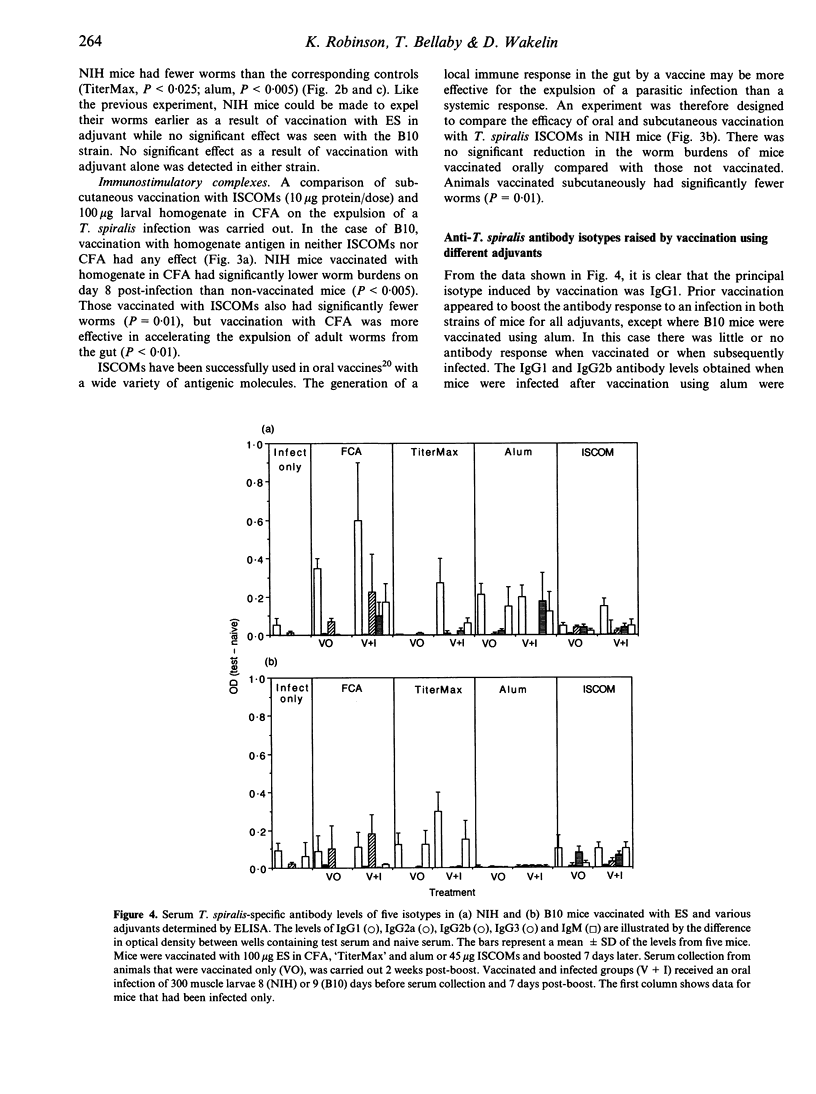

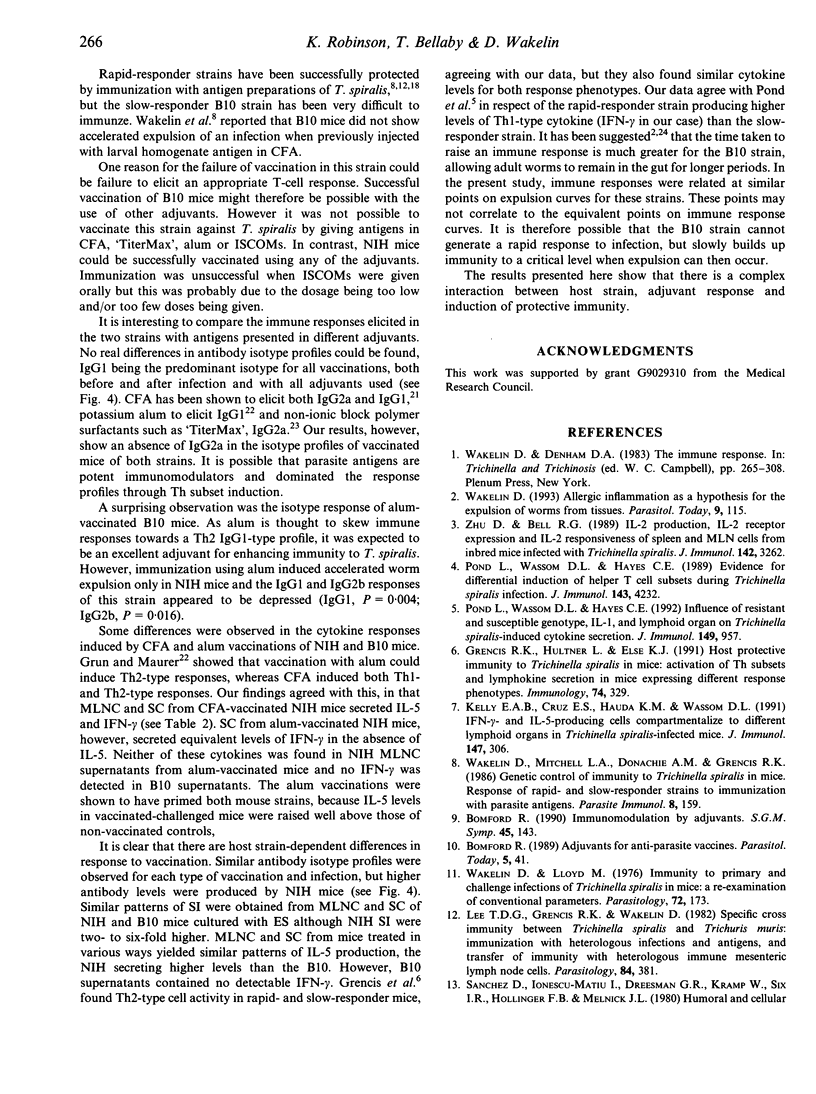
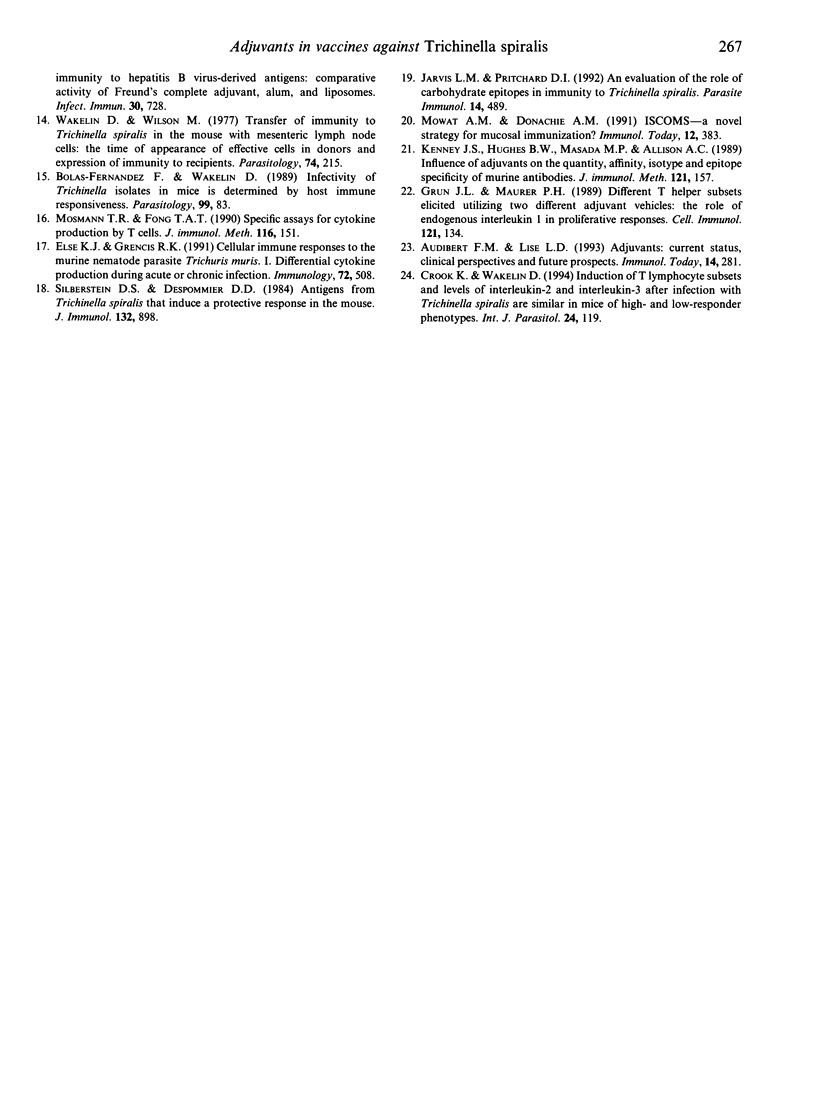
Images in this article
Selected References
These references are in PubMed. This may not be the complete list of references from this article.
- Audibert F. M., Lise L. D. Adjuvants: current status, clinical perspectives and future prospects. Immunol Today. 1993 Jun;14(6):281–284. doi: 10.1016/0167-5699(93)90046-N. [DOI] [PubMed] [Google Scholar]
- Bolas-Fernandez F., Wakelin D. Infectivity of Trichinella isolates in mice is determined by host immune responsiveness. Parasitology. 1989 Aug;99(Pt 1):83–88. doi: 10.1017/s0031182000061059. [DOI] [PubMed] [Google Scholar]
- Bomford R. Adjuvants for anti-parasite vaccines. Parasitol Today. 1989 Feb;5(2):41–46. doi: 10.1016/0169-4758(89)90190-7. [DOI] [PubMed] [Google Scholar]
- Crook K., Wakelin D. Induction of T lymphocyte subsets and levels of interleukin-2 and interleukin-3 after infection with Trichinella spiralis are similar in mice of high- and low-responder phenotypes. Int J Parasitol. 1994 Feb;24(1):119–126. doi: 10.1016/0020-7519(94)90065-5. [DOI] [PubMed] [Google Scholar]
- Else K. J., Grencis R. K. Cellular immune responses to the murine nematode parasite Trichuris muris. I. Differential cytokine production during acute or chronic infection. Immunology. 1991 Apr;72(4):508–513. [PMC free article] [PubMed] [Google Scholar]
- Grencis R. K., Hültner L., Else K. J. Host protective immunity to Trichinella spiralis in mice: activation of Th cell subsets and lymphokine secretion in mice expressing different response phenotypes. Immunology. 1991 Oct;74(2):329–332. [PMC free article] [PubMed] [Google Scholar]
- Grun J. L., Maurer P. H. Different T helper cell subsets elicited in mice utilizing two different adjuvant vehicles: the role of endogenous interleukin 1 in proliferative responses. Cell Immunol. 1989 Jun;121(1):134–145. doi: 10.1016/0008-8749(89)90011-7. [DOI] [PubMed] [Google Scholar]
- Jarvis L. M., Pritchard D. I. An evaluation of the role of carbohydrate epitopes in immunity to Trichinella spiralis. Parasite Immunol. 1992 Sep;14(5):489–501. doi: 10.1111/j.1365-3024.1992.tb00023.x. [DOI] [PubMed] [Google Scholar]
- Kelly E. A., Cruz E. S., Hauda K. M., Wassom D. L. IFN-gamma- and IL-5-producing cells compartmentalize to different lymphoid organs in Trichinella spiralis-infected mice. J Immunol. 1991 Jul 1;147(1):306–311. [PubMed] [Google Scholar]
- Kenney J. S., Hughes B. W., Masada M. P., Allison A. C. Influence of adjuvants on the quantity, affinity, isotype and epitope specificity of murine antibodies. J Immunol Methods. 1989 Jul 26;121(2):157–166. doi: 10.1016/0022-1759(89)90156-7. [DOI] [PubMed] [Google Scholar]
- Lee T. D., Grencis R. K., Wakelin D. Specific cross-immunity between Trichinella spiralis and Trichuris muris: immunization with heterologous infections and antigens and transfer of immunity with heterologous immune mesenteric lymph node cells. Parasitology. 1982 Apr;84(Pt 2):381–389. doi: 10.1017/s0031182000044929. [DOI] [PubMed] [Google Scholar]
- Mosmann T. R., Fong T. A. Specific assays for cytokine production by T cells. J Immunol Methods. 1989 Jan 17;116(2):151–158. doi: 10.1016/0022-1759(89)90198-1. [DOI] [PubMed] [Google Scholar]
- Mowat A. M., Donachie A. M. ISCOMS--a novel strategy for mucosal immunization? Immunol Today. 1991 Nov;12(11):383–385. doi: 10.1016/0167-5699(91)90133-E. [DOI] [PubMed] [Google Scholar]
- Pond L., Wassom D. L., Hayes C. E. Evidence for differential induction of helper T cell subsets during Trichinella spiralis infection. J Immunol. 1989 Dec 15;143(12):4232–4237. [PubMed] [Google Scholar]
- Pond L., Wassom D. L., Hayes C. E. Influence of resistant and susceptible genotype, IL-1, and lymphoid organ on Trichinella spiralis-induced cytokine secretion. J Immunol. 1992 Aug 1;149(3):957–965. [PubMed] [Google Scholar]
- Silberstein D. S., Despommier D. D. Antigens from trichinella spiralis that induce a protective response in the mouse. J Immunol. 1984 Feb;132(2):898–904. [PubMed] [Google Scholar]
- Wakelin D. Allergic inflammation as a hypothesis for the expulsion of worms from tissues. Parasitol Today. 1993 Apr;9(4):115–116. doi: 10.1016/0169-4758(93)90164-b. [DOI] [PubMed] [Google Scholar]
- Wakelin D., Lloyd M. Immunity to primary and challenge infections of Trichinella spiralis in mice: a re-examination of conventional parameters. Parasitology. 1976 Apr;72(2):173–182. doi: 10.1017/s0031182000048472. [DOI] [PubMed] [Google Scholar]
- Wakelin D., Mitchell L. A., Donachie A. M., Grencis R. K. Genetic control of immunity to Trichinella spiralis in mice. Response of rapid- and slow-responder strains to immunization with parasite antigens. Parasite Immunol. 1986 Mar;8(2):159–170. doi: 10.1111/j.1365-3024.1986.tb00842.x. [DOI] [PubMed] [Google Scholar]
- Wakelin D., Wilson M. M. Transfer of immunity to Trichinella spiralis in the mouse with mesenteric lymph node cells: time of appearance of effective cells in donors and expression of immunity in recipients. Parasitology. 1977 Jun;74(3):215–224. doi: 10.1017/s0031182000047843. [DOI] [PubMed] [Google Scholar]
- Zhu D. H., Bell R. G. IL-2 production, IL-2 receptor expression, and IL-2 responsiveness of spleen and mesenteric lymph node cells from inbred mice infected with Trichinella spiralis. J Immunol. 1989 May 1;142(9):3262–3267. [PubMed] [Google Scholar]



